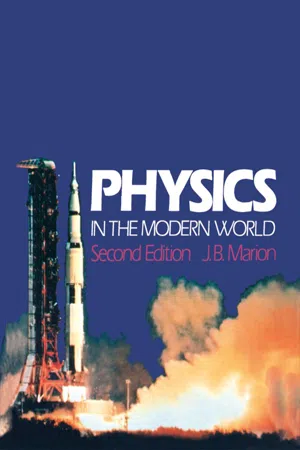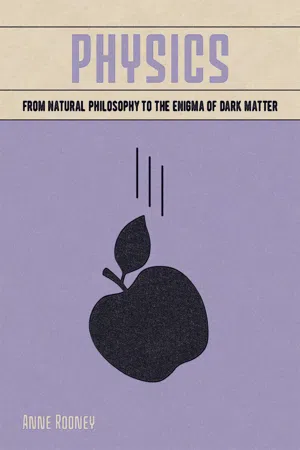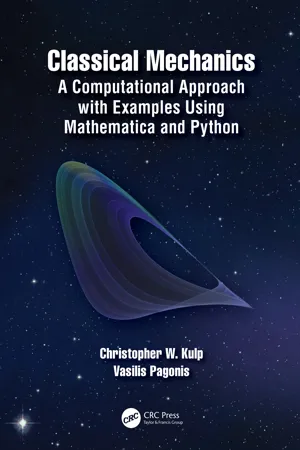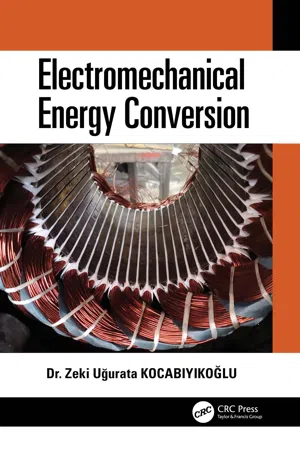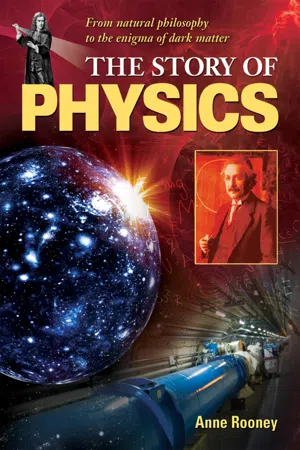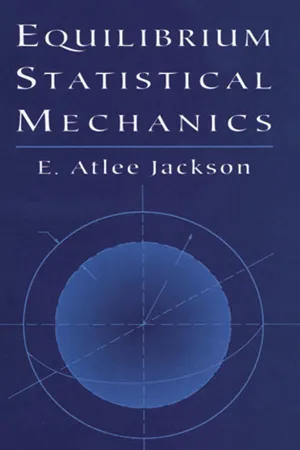Physics
Potential Energy and Energy Conservation
Potential energy is the energy stored in an object due to its position or configuration. It can be converted into kinetic energy when the object moves. Energy conservation refers to the principle that the total energy in a closed system remains constant over time, with energy being transformed from one form to another but not created or destroyed.
Written by Perlego with AI-assistance
Related key terms
Related key terms
1 of 4
Related key terms
1 of 3
10 Key excerpts on "Potential Energy and Energy Conservation"
- eBook - ePub
Newtonian Dynamics
An Introduction
- Richard Fitzpatrick(Author)
- 2021(Publication Date)
- CRC Press(Publisher)
CHAPTER 5 Conservation of Energy DOI: 10.1201/9781003198642-5 5.1 Introduction Nowadays, the conservation of energy is undoubtedly the single most important idea in physics. Strangely enough, although the basic idea of energy conservation was familiar to scientists from the time of Newton onward, this crucial concept only moved to center stage in physics in about 1850 (i.e., when scientists first realized that heat was a form of energy). According to the ideas of modern physics, energy is the fundamental substance that makes up all things in the universe. Energy can take many different forms; for instance, potential energy, kinetic energy, electrical energy, thermal energy, chemical energy, nuclear energy, etcetera. In fact, everything that we observe in the world around us represents one of the multitudinous manifestations of energy. There exist processes in the universe that transform energy from one form into another; for instance, mechanical processes (which are the focus of this book), thermal processes, electrical processes, nuclear processes, etcetera. However, all of these processes leave the total amount of energy in the universe invariant. In other words, whenever, and however, energy is transformed from one form into another, it is always conserved. For a closed system (i.e., a system that does not exchange energy with the rest of the universe), the previous law of universal energy conservation implies that the total energy of the system in question must remain constant in time. 5.2 Energy Conservation During Free-Fall Consider a mass, m, that is falling vertically under the influence of gravity. We already know how to analyze the motion of such a mass. Let us employ this knowledge to search for an expression for the conserved energy during this process. (Note that this is clearly an example of a closed system, involving only the mass and the gravitational field.) The physics of free-fall under gravity is summarized by the three equations (2.16)–(2.18) - eBook - ePub
- Jerry Marion(Author)
- 2012(Publication Date)
- Academic Press(Publisher)
movement . To make use of the potential energy possessed by an object, the potential energy must first be converted into motional energy. If we drop an object from a certain height, we know that it will accelerate due to gravity and will strike the floor with a certain velocity. The greater the height from which the object is dropped, the greater will be its impact velocity and the greater will be the kinetic energy and the amount of work that can be done.We can define the energy concept in the following way:Energy is the capacity to do work.The potential energy of a raised block, Mgh , can be converted into an equal amount of work. The potential energy is first converted into kinetic energy, Mv 2 = Mgh , and the kinetic energy is then converted into work by driving the stake into the ground. The net result of the operation is to use the original amount of potential energy to drive the stake.Conservation of Energy—Forms of Energy
In the example of the falling block, no energy is lost in any phase of the process. Work is done on the block and the block possesses this amount of energy—in the form of potential and/or kinetic energy—until the energy is given up when the block does an equivalent amount of work on the stake. The energy delivered to the stake is finally converted into heat and sound energy. Although energy is converted from one form to another, no energy is lost—energy is conserved . This important concept is summarized by the equation(7-14)E initial=E final=( K .E . + P .E . )initial( K .E . + P .E . )final(7-14)Every process known in Nature takes place in accordance with the principle of energy conservation. But the true importance of this principle cannot be fully understood or appreciated unless it is realized that energy appears in many forms. If we add up all of the energy in its various forms that an isolated system possesses before an event or process takes place and do the same afterward, we always find an exact balance. We can make this calculation only if we know all of the ways in which energy can appear. If we did not realize the existence of electric energy, for example, we would discover many situations in which there is an apparent increase or decrease in energy. - eBook - ePub
Physics
From Natural Philosophy to the Enigma of Dark Matter
- Anne Rooney(Author)
- 2020(Publication Date)
- Arcturus(Publisher)
CHAPTER 4Energy fields and forces
When a force acts to move a mass it seems obvious to us that energy is involved. So it may seem surprising that for all the consideration of forces since antiquity, energy was largely neglected by the early natural philosophers. The concept of energy is relatively new, emerging only in the 17th century. Indeed, the term ‘energy’ (from the Greek energia , coined by Aristotle) was only introduced with its modern meaning in 1807 by the genius and polymath Thomas Young (of the double-slit experiment). The most obvious forms of energy are light and heat, both of which come for free from the Sun. Humankind has also harnessed chemical energy (released by burning fuels), the gravitational energy of a falling body, the kinetic energy of wind and moving water, and, latterly, electric and nuclear energy.The conservation of energy
Just as matter is conserved, being neither created nor destroyed, so energy too is conserved. It may be converted from one form to another – and this is how we harness energy to do useful work – but that energy is never actually spent. Galileo noticed that a pendulum converts gravitational potential energy into kinetic energy or the energy of movement. When the pendulum bob is at the high point of its swing it is momentarily still, and has maximum potential energy. This is converted into kinetic energy as the bob moves, and the bob regains potential energy as it climbs up on the other side of its swing.‘There is a fact, or if you wish, a law, governing all natural phenomena that are known to date. There is no known exception to this law – it is exact so far as we know. The law is called the conservation of energy.It states that there is a certain quantity, which we call energy, that does not change in manifold changes which nature undergoes. That is a most abstract idea, because it is a mathematical principle; it says that there is a numerical quantity which does not change when something happens. It is not a description of a mechanism, or anything concrete; it is just a strange fact that we can calculate some number and when we finish watching nature go through her tricks and calculate the number again, it is the same.’ - No longer available |Learn more
- Robert A. Pelcovits, Joshua Farkas(Authors)
- 2023(Publication Date)
- Barrons Educational Services(Publisher)
Although results described in this chapter were derived from Newton’s laws, energy conservation provides a novel way to solve problems that is often easier than applying Newton’s laws directly or may be applicable in situations that are too difficult to solve with Newton’s laws. Solving problems by energy conservation is often easier because you do not have to worry about what goes on between two particular points as long as energy is conserved.Most conservation of energy problems can be solved using the most general form of the work-energy theorem:The formulas for various energies often involved areKey equation of energy conservation! U is the total potential energy, including gravitational and elastic energies.If you need to compute the work done by an arbitrary force, you may need to integrate the equationAlthough power generally is not a useful way to solve problems, you may be required to calculate or use power, which requires the power equations:Force can be related to potential energy in the absence of nonconservative forces:And of course, do not forget the spring force:valid only in the absence of nonconservative forcesForce due to a springCHAPTER SUMMARYDefining “work” in a particular way allows us to recast Newton’s second law in a very convenient form: the work-energy theorem. If the work done by a force on an object is independent of the path followed by the object, a “potential energy” associated with this force can be defined. Two examples of such conservative forces are gravity and the spring force. In the presence of conservative forces, an object’s total mechanical energy, kinetic plus potential, is conserved.Practice Exercises
Multiple-Choice Questions
1 .In Figure 4.6 the person pulls the mass (initially at rest) all the way to the top of the incline and then allows it to slide halfway down the incline before exerting enough tension force to stop the mass at this point. If the coefficient of kinetic friction is μk and the length of the incline is d - eBook - ePub
- A. L. Stanford, J. M. Tanner(Authors)
- 2014(Publication Date)
- Academic Press(Publisher)
0→8 is 1300 J. Then we obtainv 8 2=12 2+ 2( 1300 )/ 10 = 400v 8= 20 m / sPotential Energy
We have seen that the kinetic energy of a particle depends on the mass and speed of that particle. Although we usually measure the speed of a particle relative to the earth, the kinetic energy of that particle is associated with the particle itself. Now we consider a second form of mechanical energy called potential energy . Like kinetic energy, potential energy represents the ability to do work. But potential energy arises because of interactions between two or more bodies. Thus the potential energy of a system of interacting objects represents the ability of the system to do work because of its configuration.Here we shall consider two forms of mechanical potential energy: gravitational and elastic. The gravitational potential energy that we shall associate with a particle arises from the configuration of the particle and the earth, a system that is interacting by means of the gravitational force. Elastic energy, on the other hand, arises from the configuration of a spring or some similar device that may have the ability to do work in stressed configurations. Let us examine gravitational potential energy first.Gravitational Potential Energy
A particle anywhere outside the earth interacts with the earth through the attractive gravitational forces on the particle and the earth. We shall, for convenience, separate the special case of a particle near the surface of the earth from the more general case because many of the situations we encounter occur near the surface of the earth.Let us consider first the near-earth situation, in which the magnitude g of the free-fall acceleration of a body is constant. We designate some reference position along the vertical to be y = 0. This arbitrary choice gives us a reference level from which vertical distances may be measured. Let us define the gravitational potential energy of a particle to be zero at the reference level y = 0. At any other vertical position, such as y = h , the gravitational potential energy is defined to be the work that the gravitational force would do on the particle if the particle were moved from a position at y = h to the reference level y - eBook - ePub
Classical Mechanics
A Computational Approach with Examples Using Mathematica and Python
- Christopher W. Kulp, Vasilis Pagonis(Authors)
- 2020(Publication Date)
- CRC Press(Publisher)
5.1.12 ), we see that solving problems using conservation of energy requires only that we compare one state of the system to another. For example, suppose we drop a rock starting at rest from a height of 5 m above the ground and we want to know the kinetic energy of the rock after it fell 2 m. All we need is to know is the initial kinetic energy (which is zero) and the initial and final potential energies in order to obtain the final kinetic energy (and thus the speed). We don’t need information about the state of the system during the actual fall!Equation (5.1.12 ) also tells us that if the potential energy of the system decreases, its kinetic energy must increase and vice versa, in order to maintain the equality of both sides of the equation. The ability to interpret the meanings behind equations such as (5.1.8 ) and (5.1.12 ) is an important skill for physicists.Example 5.1: Simple harmonic motion and conservation of energyConsider a mass m on a spring with spring constant k performing simple harmonic motion with amplitude A. The force is given by Hooke’s law F = −kx where x is the displacement from equilibrium.(a) Find the total mechanical energy in terms of A.(b) Find an expression for the turning points in the motion, the points at which the velocity v of the particle is zero and the mass turns around, as a function of the total mechanical energy E and spring constant k.Solution:(a) We will solve this problem using energy conservation. In order to use energy conservation, we need to first find the potential energy associated with the spring. The potential energy associated with the force of the spring is called the elastic potential energy - eBook - ePub
- Zeki Uğurata Kocabiyikoğlu(Author)
- 2020(Publication Date)
- CRC Press(Publisher)
Figure 1.3 ).FIGURE 1.3 Water wheel and windmill.1.1.1.1 Potential Energy
In more general terms, we can define energy as the work done in moving an object to a certain distance x under a certain force F . The product of force and distance would give the amount of work done or the energy spent during this process. An important thing to remember about gravitational potential energy “mgh”, where m is the mass, g is the gravitational constant, and h is the height, is that the amount of energy stored by moving a mass to a higher altitude is independent of how (through which path) the mass got to its final position (Figure 1.4 ).FIGURE 1.4 Potential energy = mgh.Exercise 1.1: A crane is made to lift a load of 4,000 kg to an altitude of 300 m. How much energy must the motor provide (neglect losses in the hoist mechanism)? Solution:Energy = 4000 × 9.81 × 300 = 11.77 MJ1.1.1.2 Kinetic Energy
The kinetic energy stored in a moving mass is given by- For linear motion →E = mv 2 /2 (Figure 1.5a )
- For rotational motion →E = Iω 2 /2 (Figure 1.5b )
FIGURE 1.5a Linear motion.FIGURE 1.5b Rotational motion.Here, m is the mass of the object, v is its velocity, I is its moment of inertia, and ω is its angular velocity in radians/second.The potential energy of a pond of water at a hill is much more useful than the kinetic energy of a truck. Rotational kinetic energy is an important actor when load changes take place in the electrical power systems.When customers demand more power, the rotors of the generators slow down, thus reducing their stored kinetic energy (Figure 1.6 - eBook - ePub
- Anne Rooney(Author)
- 2014(Publication Date)
- Arcturus(Publisher)
CHAPTER 4
ENERGY
fields and forces
Lightning and wind represent massive bursts of energy in nature, feared for their destructive powerWhen a force acts to move a mass it seems obvious to us that energy is involved. So it may seem surprising that for all the consideration of forces since antiquity, energy was largely neglected by the early natural philosophers. The concept of energy is relatively new, emerging only in the 17th century. Indeed, the term ‘energy’ (from the Greekenergia, coined by Aristotle) was only introduced with its modern meaning in 1807 by the genius and polymath Thomas Young (of the double-slit experiment). The most obvious forms of energy are light and heat, both of which come for free from the sun. Humankind has also harnessed chemical energy (released by burning fuels), the gravitational energy of a falling body, the kinetic energy of wind and moving water, and, latterly, electric and nuclear energy.The conservation of energy
Just as matter is conserved, being neither created nor destroyed, so energy too is conserved. It may be converted from one form to another – and this is how we harness energy to do useful work – but that energy is never actually spent. Galileo noticed that a pendulum converts gravitational potential energy into kinetic energy or the energy of movement. When the pendulum bob is at the high point of its swing it is momentarily still, and has maximum potential energy. This is converted into kinetic energy as the bob moves, and the bob regains potential energy as it climbs up on the other side of its swing.Pendulum clocks were first developed in 1656 by Christiaan Huygens: the pendulum always takes the same time to swingINVENTING ‘ENERGY ’
That different types of energy are equivalent was not immediately obvious. Even now there is no fundamental understanding of exactly what energy is and how it works. The German mathematician Gottfried Leibnitz (1646–1716) explained mathematically the conversion between different types of energy, which he called vis viva. - eBook - ePub
Janice VanCleave's Physics for Every Kid
Easy Activities That Make Learning Science Fun
- Janice VanCleave, Tina Cash Walsh(Authors)
- 2021(Publication Date)
- Jossey-Bass(Publisher)
Hz), where 1 Hz = 1 cycle per second or one back and forth vibration.Potential energy is the energy an object has because of its position relative to some zero position. It is energy that has the potential to do ‘work.’ Two types of potential energy investigated in this book are gravitational potential energy and elastic potential energy.- Gravitational potential energy is the stored energy an object has because of its position above a specific ground zero. This type of potential energy is due to the force of gravity acting on the object. To obtain this energy, work had to be done on an object to raise it to a higher level above ground zero, such as placing a book on a top shelf with the floor below being ground zero. Gravitational potential energy is directly related to the mass of the object as well as its height above ground zero. When the book is dropped from a specific height, its gravitational potential energy is converted to kinetic energy as the book falls.
- Elastic potential energy is the energy stored in an object that can be stretched or compressed. A force is needed to compress or stretch an elastic object. Consider a trampoline, which has the greatest elastic potential energy when it is stretched the most, as does a rubber band. A coiled spring stores elastic potential energy when a force compresses it as well as when a force stretches it. In both cases, when the spring is released, the spring's elastic potential energy results in the wound coils moving back to their normal position. Thus, the elastic potential energy is converted to kinetic energy.
Kinetic energy (KE) is the energy of objects that are moving. Remember, kinetic energy does not cause an object to move, instead objects have kinetic energy because they are moving. A ball at the top of a ramp has gravitational potential energy. As the ball rolls down the ramp, its gravitational potential energy is converted to kinetic energy. There are three types of kinetic energy: vibrational, rotational, and translational. Vibrational KE is the energy caused by a back and forth movement; rotational KE is the result of turning about an axis, and translational KE - eBook - ePub
- E. Atlee Jackson(Author)
- 2012(Publication Date)
- Dover Publications(Publisher)
models (simplified pictures) of atoms, molecules, gases, and solids will illustrate the various types of interactions between particles. Finally, we shall consider some of the important modifications of these classical models that are required by quantum mechanics.2. KINETIC AND POTENTIAL ENERGY
To begin with, let us consider a particle moving in space as it is described in classical mechanics. The position of the particle r (t ) = x (t )i + y (t )j + z (t )k [where (i, j, k ) are the unit vectors in the (x , y , z ) directions] generally varies in time and has a velocityIf the particle has a mass m, it is said to have a kinetic energy (sometimes called the translational energy )(1)If a force F acts on the particle, its velocity will change according to Newton’s law(2)If no force acts on the particle, then it follows from Equation (2) that v is independent of the time, and consequently the kinetic energy is also a constant. We can also see this from the fact that(3)which vanishes if F vanishes.Now the force that acts on the particle generally depends on the position of the particle r and sometimes also on the velocity (e.g., frictional forces, or the force on a charged particle moving in a magnetic field). If the force depends only on r and if it can be expressed in terms of the gradient of some function Φ
Index pages curate the most relevant extracts from our library of academic textbooks. They’ve been created using an in-house natural language model (NLM), each adding context and meaning to key research topics.
Explore more topic indexes
Explore more topic indexes
1 of 6
Explore more topic indexes
1 of 4

